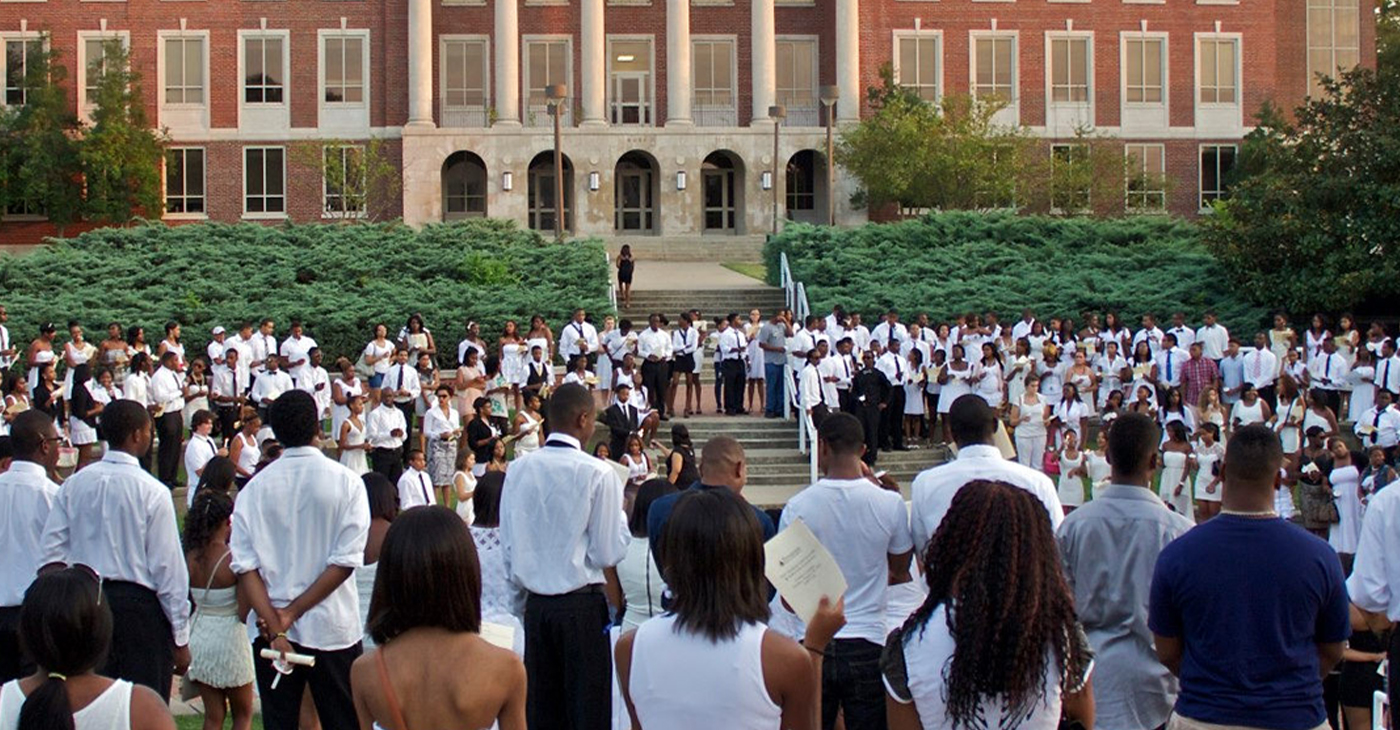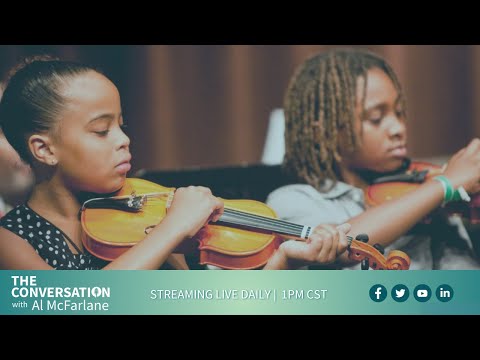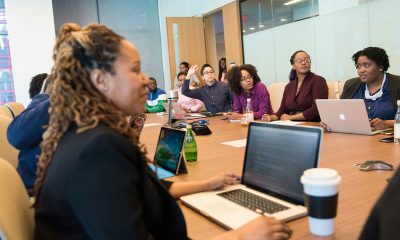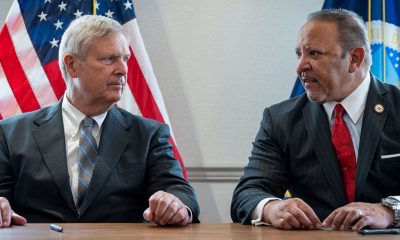#NNPA BlackPress
‘THE AMERICAN AUDIT’ exposes America as a 400-year old business and its toll on Black humanity
NNPA NEWSWIRE — To pull together photographs, videos, and audio records he collected for this performance, Rose interviewed researchers and activists including Michael ‘Quess’ Moore, who co-founded Take ‘Em Down NOLA; Maxine Crump, CEO of Dialogue on Race-Louisiana; Chris Tyson, president of Build Baton Rouge, Jason Perkins, Ph.D., professors Eva Baham and Lori Martin; LSU history chairman Aaron Sheehan-Dean, Ph.D.; Southern University law professor Angela Allen-Bell; historian Thomas Durant, and many others, he said.
By Candice Semien, The DRUM Newspaper
Baton Rouge spoken-word artist and activist Donney Rose has amassed more than 2,000 travel miles conducting hours of interviews and days of research in order to create an epic narrative that unravels 400 years of American History.
It is an ambitious presentation called “The America Audit” where Rose explores America as a business and exposes its toll on Black citizens fiscally, spiritually, judicially, emotionally, and socially.
To do so, Kennedy Center Citizen Artist Fellow committed up to 15 hours a week for a year to complete this “audit.”
“I am going all in,” Rose said, “The poem is one epic poem broken into nine different parts which all begin with a technical term used in an audit.”
Last year, he performed excerpts of The American Audit at the 2019 Arts Summit of the John F. Kennedy Center for the Performing Arts, the University of Northern Iowa, and Festival of Words in Grand Coteau.
To pull together photographs, videos, and audio records he collected for this performance, Rose interviewed researchers and activists including Michael ‘Quess’ Moore, who co-founded Take ‘Em Down NOLA; Maxine Crump, CEO of Dialogue on Race-Louisiana; Chris Tyson, president of Build Baton Rouge, Jason Perkins, Ph.D., professors Eva Baham and Lori Martin; LSU history chairman Aaron Sheehan-Dean, Ph.D.; Southern University law professor Angela Allen-Bell; historian Thomas Durant, and many others, he said.
The Jozef Syndicate asked Rose to share more on The American Audit which will showcase 7pm on Feb 28 at the Manship Theatre in Baton Rouge.
JS: American Audit is described as a multimedia, spoken word project that chronicles 400 years of Black American life using the extended metaphor of America as a business audited by African Americans (today). How else do you describe it to others?
ROSE: This has been my general explanation but I additionally add that it’s not just an exploration of financial/fiscal aspects of Black labor and humanity being audited, it’s also an exploration of the social, emotional, physical and psychological toll of the African-American experience and what findings come up when doing a deep dive into all of those layers
JS: How did you decide on this topic and why multimedia?
ROSE: In late 2018, I began thinking about the pending 400-year anniversary of the first documented enslaved Africans being brought to Jamestown. I knew that there would be several writings, discussions etc. about this historical milestone and wanted to find an artistic lens to approach it. Seeing that enslaved Africans were brought to this land under the guise of economics, I figured what better way to approach the topic than by writing about a fictional audit being done. The multimedia aspect of it was to expand my presentation. After 20 years of performing poetry, I didn’t want to just get behind a mic and perform this content. I wanted to do a deeper dive that would allow me to talk to history and cultural experts and display those discussions interwoven with the performative text.
JS: Why this topic now?
ROSE: The plan was to have the project finished for 2019 to be in accordance with the commemorative year. There were a few setbacks that did not allow that to manifest, but I knew there would still be relevance going into this year. I have previewed excerpts of the project in various settings and the consensus is that is timely and very relevant to the times we are in.
JS: Is this a stand-alone project of Donney Rose or connected to Black Out Loud?
ROSE: The project is a stand-alone, however, components of it are likely to be incorporated in future Black Out Loud programming.
JS: How did you know you wanted to do this work?
ROSE: What I really knew was that I wanted to push my artistry beyond the confines I had set for myself. Over the last few years, I have become a much more avid reader and cultural observer of politics and social behavior and how we, as Black Americans, respond to structural and systemic facets of our lives that were created beyond our control.
JS: Before performing your poem “New Definitions,” you said a continuum of one conversation of Blackness is vital and necessary. What is that conversation and does this project contribute to it?
ROSE: I believe that the continuum of the conversation referenced is a continual deep dive into our humanity. So much of Black oppression has been rooted in dehumanization. Which is to say if you can convince African Americans that somehow their existence is less than, you can continue to marginalize them is a variety of ways. The American Audit absolutely gets to the root of dehumanization and explores the why and how.
JS: What was the most interesting place (physically) that this project has taken you? How would you describe it?
ROSE: Very early I visited the Whitney Plantation and that was a fascinating visit because of our tour guide. It was interesting to see just how vital sugar cane was to the area, because typically when we think slave labor we default to the idea of cotton being picked. I would say one of the other more interesting places I visited was the Federal Reserve of Philadelphia. It’s an interesting museum that details the how and why of currency production. There weren’t explicit displays about slavery there but it was easy to connect certain dots when you saw information about the origins of American currency.
JS: What was the most provocative discovery you made? How is it presented in the project?
ROSE: Some of the most striking imagery comes by way of two visits to the Smithsonian National Museum of African American History and Culture in Washington DC. It’s such a visually stunning museum to visit and it allowed me to gain access to gripping images I would not have gotten anywhere else. The writing, in general, is pretty provocative as I am more or less trying to make a case for America as a metaphorical business to undergo an audit for its treatment of Black people.
JS: Have you experienced frustration in creating this project? How do you work through the harder parts?
ROSE: I have had moments in which I have wondered if I am being complete and exact in the writing, but I’ve had to understand that this one project will not be the answer to generations of inequity or dehumanization. That there will always be interrogations of this country by various people who are curious or bold enough to question it for what it is.
JS: Who’s helped produce this and to what capacity?
ROSE: My main co-creator is Steven Baham. He is doing videography work filming all the interviews and assisting with storyboarding/editing the final product. Leslie Rose has also been instrumental in doing photography work for a lion share of the images.
JS: Is there a call to action with this work?
ROSE: There’s not necessarily a ‘call to action’ per se. The project is mostly a creative analysis of what this nation has been to and for Black people. Framed through the lens of economics because money, finance, and wealth are universal in the sense that this country consists of people who either have it or who are striving for prosperity.
JS: Where does The American Audit go from here?
ROSE: Hopefully the performance goes to other parts of the country. After the February 28th debut, a few more interviews will be conducted, ideally with scholars, experts, and activists out of state.
JS: Audre Lorde wrote, “We must wake up knowing we have work to do and go to bed knowing we’ve done it.” With the work you’ve desired for the American Audit, do you get to point of being “done”?
ROSE: For this particular project, yes.
ONLINE:
Instagram: the_american_audit
www.manshiptheatre.org
Donneyrosepoetry.com
#NNPA BlackPress
IN MEMORIAM: Ramona Edelin, Influential Activist and Education Advocate, Dies at 78
NNPA NEWSWIRE — Born on September 4, 1945, in Los Angeles, California, activist Ramona Edelin’s early years were marked by a commitment to education and social justice. According to her HistoryMakers biography, after graduating from Fisk University with a Bachelor’s degree in 1967, she pursued further studies at the University of East Anglia in England. She earned her master’s degree before completing her Ph.D. at Boston University in 1981.
The post IN MEMORIAM: Ramona Edelin, Influential Activist and Education Advocate, Dies at 78 first appeared on BlackPressUSA.

By Stacy M. Brown, NNPA Newswire Senior National Correspondent
@StacyBrownMedia
Once upon a time, Black Americans were simply known as colored people, or Negroes. That is until Ramona Edelin came along. The activist, renowned for her pivotal roles in advancing civil rights, education reform, and community empowerment, died at her D.C. residence last month at the age of 78. Her death, finally confirmed this week by Barnaby Towns, a communications strategist who collaborated with Dr. Edelin, was attributed to cancer.
Born on September 4, 1945, in Los Angeles, California, Edelin’s early years were marked by a commitment to education and social justice. According to her HistoryMakers biography, after graduating from Fisk University with a Bachelor’s degree in 1967, she pursued further studies at the University of East Anglia in England. She earned her master’s degree before completing her Ph.D. at Boston University in 1981.
Edelin’s contributions to academia and activism were manifold. She was pivotal in popularizing the term “African American” alongside Rev. Jesse L. Jackson in the late 1980s.
Jackson had announced the preference for “African American,” speaking for summit organizers that included Dr. Edelin. “Just as we were called Colored, but were not that, and then Negro, but not that, to be called Black is just as baseless,” he said, adding that “African American” “has cultural integrity” and “puts us in our proper historical context.”
Later, Edelin told Ebony magazine, “Calling ourselves African Americans is the first step in the cultural offensive,” while linking the name change to a “cultural renaissance” in which Black Americans reconnected with their history and heritage.
“Who are we if we don’t acknowledge our motherland?” she asked later. “When a child in a ghetto calls himself African American, immediately he’s international. You’ve taken him from the ghetto and put him on the globe.”
The HistoryMakers bio noted that Edelin’s academic pursuits led her to found and chair the Department of African American Studies at Northeastern University, where she established herself as a leading voice.
Transitioning from academia to advocacy, Edelin joined the National Urban Coalition in 1977, eventually ascending to president and CEO. During her tenure, she spearheaded initiatives such as the “Say Yes to a Youngster’s Future” program, which provided crucial support in math, science, and technology to youth and teachers of color in urban areas. Her biography noted that Edelin’s efforts extended nationwide through partnerships with organizations like the National Science Foundation and the United States Department of Education.
President Bill Clinton recognized Edelin’s expertise by appointing her to the Presidential Board on Historically Black Colleges and Universities in 1998. She also co-founded and served as treasurer of the Black Leadership Forum, solidifying her standing as a respected leader in African American communities.
Beyond her professional achievements, Edelin dedicated herself to numerous boards and committees, including chairing the District of Columbia Educational Goals 2000 Panel and contributing to the Federal Advisory Committee for the Black Community Crusade for Children.
Throughout her life, Edelin received widespread recognition for her contributions. Ebony magazine honored her as one of the 100 Most Influential Black Americans, and she received prestigious awards such as the Southern Christian Leadership Award for Progressive Leadership and the IBM Community Executive Program Award.
The post IN MEMORIAM: Ramona Edelin, Influential Activist and Education Advocate, Dies at 78 first appeared on BlackPressUSA.
#NNPA BlackPress
Tennessee State University Board Disbanded by MAGA Loyalists as Assault on DE&I Continues
NNPA NEWSWIRE — Recent legislative actions in Tennessee, such as repealing police reform measures enacted after the killing of Tyre Nichols, underscore a troubling trend of undermining local control and perpetuating racist agendas. The new law preventing local governments from restricting police officers’ authority disregards community efforts to address systemic issues of police violence and racial profiling.
The post Tennessee State University Board Disbanded by MAGA Loyalists as Assault on DE&I Continues first appeared on BlackPressUSA.

By Stacy M. Brown, NNPA Newswire Senior National Correspondent
@StacyBrownMedia
Tennessee State University (TSU), the state’s only public historically Black college and university (HBCU), faces a tumultuous future as Gov. Bill Lee dissolved its board, a move supported by racist conservatives and MAGA Republicans in the Tennessee General Assembly, who follow the lead of the twice-impeached, four-times indicted, alleged sexual predator former President Donald Trump. Educators and others have denounced the move as an attack on diversity, equity, and inclusion (DE&I) and a grave setback for higher education.
Critics argue that TSU’s purported financial mismanagement is a manufactured crisis rooted in decades of underinvestment by the state government. They’ve noted that it continues a trend by conservatives and the racist MAGA movement to eliminate opportunities for Blacks in education, corporate America, and the public sector.
Gevin Reynolds, a former speechwriter for Vice President Kamala Harris, emphasizes in an op-ed that TSU’s financial difficulties are not the result of university leadership because a recent audit found no evidence of fraud or malfeasance.
Reynolds noted that the disbanding of TSU’s board is not an isolated incident but part of a broader assault on DE&I initiatives nationwide. Ten states, including Tennessee, have enacted laws banning DE&I policies on college campuses, while governors appointing MAGA loyalists to university trustee positions further undermine efforts to promote inclusivity and equality.
Moreover, recent legislative actions in Tennessee, such as repealing police reform measures enacted after the killing of Tyre Nichols, underscore a troubling trend of undermining local control and perpetuating racist agendas. The new law preventing local governments from restricting police officers’ authority disregards community efforts to address systemic issues of police violence and racial profiling.
The actions echo historical efforts to suppress Black progress, reminiscent of the violent backlash against gains made during the Reconstruction era. President Joe Biden warned during an appearance in New York last month that Trump desires to bring the nation back to the 18th and 19th centuries – in other words, to see, among other things, African Americans back in the chains of slavery, women subservient to men without any say over their bodies, and all voting rights restricted to white men.
The parallels are stark, with white supremacist ideologies used to justify attacks on Black institutions and disenfranchise marginalized communities, Reynolds argued.
In response to these challenges, advocates stress the urgency of collective action to defend democracy and combat systemic racism. Understanding that attacks on institutions like TSU are symptomatic of broader threats to democratic norms, they call for increased civic engagement and voting at all levels of government.
The actions of people dedicated to upholding the principles of inclusivity, equity, and justice for all will determine the outcome of the ongoing fight for democracy, Reynolds noted. “We are in a war for our democracy, one whose outcome will be determined by every line on every ballot at every precinct,” he stated.
The post Tennessee State University Board Disbanded by MAGA Loyalists as Assault on DE&I Continues first appeared on BlackPressUSA.
#NNPA BlackPress
Braxton Haulcy and the Expansion of Walker|West Music Academy
May 24, 2023 – Walker West Music Academy gets an early start on expansion. Join us for a Wednesday episode of The …
The post Braxton Haulcy and the Expansion of Walker|West Music Academy first appeared on BlackPressUSA.

May 24, 2023 – Walker West Music Academy gets an early start on expansion. Join us for a Wednesday episode of The …
The post Braxton Haulcy and the Expansion of Walker|West Music Academy first appeared on BlackPressUSA.
-

 Activism4 weeks ago
Activism4 weeks agoOakland Post: Week of March 27 – April 2, 2024
-

 #NNPA BlackPress4 weeks ago
#NNPA BlackPress4 weeks agoBeloved Actor and Activist Louis Cameron Gossett Jr. Dies at 87
-

 Community1 week ago
Community1 week agoFinancial Assistance Bill for Descendants of Enslaved Persons to Help Them Purchase, Own, or Maintain a Home
-

 Activism3 weeks ago
Activism3 weeks agoOakland Post: Week of April 3 – 6, 2024
-

 Business1 week ago
Business1 week agoV.P. Kamala Harris: Americans With Criminal Records Will Soon Be Eligible for SBA Loans
-

 Activism2 weeks ago
Activism2 weeks agoOakland Post: Week of April 10 – 16, 2024
-

 Community1 week ago
Community1 week agoAG Bonta Says Oakland School Leaders Should Comply with State Laws to Avoid ‘Disparate Harm’ When Closing or Merging Schools
-

 Community6 days ago
Community6 days agoOakland WNBA Player to be Inducted Into Hall of Fame
























































